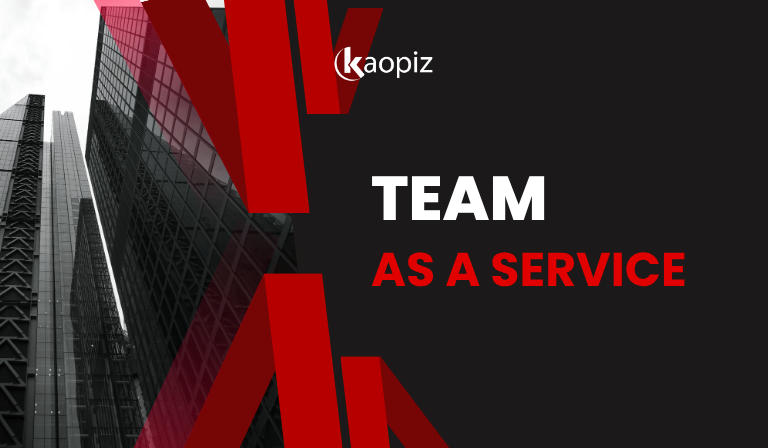Elevating Business Performance with Kaopiz’s IT Service Management: A Strategic Guide
In today’s digitally driven economy, organizations must not only leverage technology—they must manage the delivery of technology-enabled services with precision, clarity and alignment with business goals. That’s where IT service management (ITSM) enters the stage: a holistic, process-oriented approach to designing, delivering, operating, and improving IT services.
In this blog post we explore what ITSM really means, why it matters, how it works in practice, and how forward-looking organizations in Vietnam and beyond can embrace it for business value.
Table of Contents
- What Is IT Service Management (ITSM)?
- Why ITSM Matters for Modern Businesses
- Core Processes of IT Service Management
- ITSM vs. IT Operations vs. DevOps
- Best Practices for Effective ITSM Implementation
- Common Challenges in ITSM
- Kaopiz Expertise in IT Service Management
- Future Trends in IT Service Management
- Conclusion
- FAQs
What Is IT Service Management (ITSM)?
IT Service Management refers to a comprehensive approach to designing, delivering, operating, and improving IT services that support business goals. Rather than viewing IT as a reactive support function, ITSM positions it as a value-driven partner aligned with strategic objectives.
Leading frameworks such as ITIL (Information Technology Infrastructure Library) define ITSM as a process-based practice focused on customer outcomes, service quality, and continuous improvement.
Why ITSM Matters for Modern Businesses
Technology underpins every business function—from customer service to data-driven decision-making. IT Service Management ensures these technologies operate efficiently, securely, and strategically, aligning IT performance with organizational goals and long-term growth.
- Strategic alignment: ITSM ensures every service and initiative maps to a business goal—speed to market, regulatory compliance, or superior customer experience. This alignment moves IT from a cost center to a value creator.
- Service quality and reliability: Clear processes and SLAs reduce downtime, accelerate response and resolution, and improve consistency across teams and time zones.
- Cost optimization: Standard workflows, automation, and knowledge reuse eliminate waste and rework. Self-service deflects tickets; change governance prevents expensive outages.
- Scalability with control: As organizations adopt cloud, SaaS, and microservices, ITSM provides the guardrails—service catalogs, change controls, configuration visibility—to scale without chaos.
- Continuous improvement: Metrics and feedback loops turn operational data into improvement actions. Over time, the same team delivers more value with fewer surprises.
Core Processes of IT Service Management
While every organization tailors its system, these core capabilities form a proven foundation:
- Incident Management: Restore service fast when something breaks. Triage, prioritize, and resolve incidents with clear ownership and escalation paths. Track mean time to acknowledge (MTTA) and mean time to resolve (MTTR) to drive improvements.
- Problem Management: Prevent recurrence by identifying root causes of repeating incidents. Use post-incident reviews, trend analysis, and known error databases to turn lessons learned into permanent fixes.
- Request Fulfillment: Handle standard needs—access, software installs, hardware requests—via a service catalog with predictable SLAs. Automate approvals and routing for speed and transparency.
- Change Enablement (Change Management): Reduce risk when introducing changes to apps, infrastructure, data pipelines, or configurations. Distinguish standard vs. normal vs. emergency changes; use a change calendar and impact assessments to minimize disruptions.
- Release & Deployment Management: Plan, package, test, and deploy releases so new features arrive smoothly. Integrate with CI/CD pipelines and standard rollback mechanisms.
- Configuration & Asset Management (CMDB): Maintain a trusted map of services and their underlying components (applications, databases, cloud resources). This visibility improves impact analysis, incident diagnosis, and audit readiness.
- Service Level Management: Define, negotiate, and monitor SLAs and OLAs (operational level agreements). Match expectations with capacity and budget, and use SLA trends to guide investments.
- Knowledge Management: Capture solutions, workarounds, and how-tos in a searchable knowledge base. Enable self-service and coach agents to contribute high-quality articles as part of “done.”
- Continual Improvement: Use KPIs, user feedback, and audits to prioritize enhancements. Apply a simple PDCA (Plan-Do-Check-Act) loop or ITIL continual improvement model to keep momentum.
ITSM vs. IT Operations vs. DevOps
ITSM defines how services are managed across their lifecycle—governance, process, value, and customer experience.
IT Operations (ITOps) runs the day-to-day: infrastructure monitoring, backups, capacity, security patches, and routine maintenance. Many ITOps activities sit inside the ITSM umbrella.
DevOps focuses on how software is built and delivered—collaboration between development and operations, automation, CI/CD, and observability. DevOps accelerates change; ITSM ensures those changes are safe, recoverable, and valuable.
In mature organizations, these disciplines complement one another:
- DevOps optimizes flow from code to production.
- ITSM ensures service reliability, compliance, and customer outcomes.
- ITOps provides the steady-state operational muscle.
Best Practices for Effective ITSM Implementation
Implementing IT Service Management successfully requires a balance between structured processes and adaptability—focusing on proven best practices that enhance efficiency, reliability, and continuous improvement across the organization.
- Start with services and outcomes: Define your service catalog from the user’s perspective: what they can request, what they get, and the expected SLA.
- Right-size your processes: Avoid bureaucracy. Keep workflows as lean as possible while still managing risk, compliance, and scale.
- Automate the repetitive: Auto-triage tickets, route requests based on categories, enable password resets and account provisioning via self-service, and automate standard changes.
- Instrument everything: Establish a KPI baseline (e.g., incident volumes by category, MTTR, change success rate, ticket deflection, CSAT). Use dashboards to drive action.
- Embed knowledge: Make “create/update a KB article” part of the definition of done for incidents, problems, and changes.
- Engineer for reliability: Treat reliability as a feature: use SLOs, error budgets, chaos testing (where appropriate), and progressive delivery (canary, blue/green).
- Strengthen change governance without slowing DevOps: Pre-approve truly low-risk standard changes; integrate change records with CI/CD so governance is visible but not manual friction.
- Invest in people and culture: Train process owners, service owners, and agents. Communicate why changes are happening and how they help customers.
Common Challenges in ITSM
While IT Service Management brings immense value, many organizations face hurdles when trying to adopt or scale it effectively, ranging from cultural resistance and process overload to tool misalignment and data inconsistency.
- Process overload: Over-engineering kills adoption. Fix by pruning steps and focusing on a small set of high-impact controls.
- Tool-first thinking: Tools don’t fix broken processes. Define desired behaviors and outcomes, then select tooling that supports them.
- Siloed teams: Hand-offs create delays. Align incentives, use shared dashboards, and form cross-functional swarms for major incidents.
- Poor data hygiene: A stale CMDB or inconsistent ticket categories undermine decision-making. Assign ownership; make accuracy a performance goal.
- Change fatigue: Pace major shifts, provide training, and celebrate wins. Pair new responsibilities with tangible benefits (e.g., fewer pages, faster approvals).
Kaopiz Expertise in IT Service Management
Kaopiz is a trusted IT managed service provider with a decade-long track record, 600+ professionals, and 1000+ delivered projects across startups and global enterprises. We serve clients in Japan, Singapore, Hong Kong, Australia, the U.S., and the EU from offices in Vietnam and Japan.

We uphold ISO 27001 (information security) and ISO 9001 (quality management), hold ISTQB Platinum for testing excellence, and maintain AWS Advanced Consulting and AWS Well-Architected partner accreditations. These credentials reflect our commitment to secure, reliable, and cost-effective service delivery.
Our ITSM approach:
- Lifecycle coverage: service design → transition → operation → continual improvement.
- Outcome-led engagements: we align SLAs/SLOs with business goals (e.g., faster onboarding, higher conversion, lower cost-to-serve).
- Cloud-ready governance: we blend ITSM with cloud-native practices—observability, autoscaling, immutable infrastructure—to protect speed and safety.
- Automation everywhere: from self-service portals and knowledge bases to automated routing, approvals, and release workflows.
- Transparent reporting: regular service reviews, dashboards for MTTR, change success rate, SLA attainment, backlog health, and ticket deflection.
Our fusion of IT service management and cloud services gives clients dependable operations with the agility to innovate. We design seamless migrations, implement well-architected infrastructures, and sustain performance with real-time monitoring and ITSM-driven oversight—so you scale confidently without compromising reliability or security.
Future Trends in IT Service Management
- AI-assisted service: Intelligent triage, virtual agents, and predictive analytics will cut resolution times and prevent incidents before they occur.
- Experience-centric ITSM: Metrics will evolve from SLAs to XLAs (experience-level agreements), measuring friction, satisfaction, and business impact—not just uptime.
- FinOps + ITSM: As cloud spend grows, cost governance becomes part of service management: showback/chargeback, rightsizing, and automated cost controls integrated into change and release processes.
- DevOps, SRE, and ITSM convergence: Expect tighter integration between incident response, SLOs/error budgets, and change automation—uniting speed with resilience.
- Security by default: ITSM processes will embed zero-trust principles, automated compliance checks, and supply-chain visibility as standard steps in service delivery.
- Composability and platform engineering: Internal developer platforms will package golden paths (secure, compliant blueprints) so product teams can deliver fast while ITSM maintains governance.
Conclusion
IT service management is the backbone of reliable, value-centric technology operations. Combined with modern cloud capabilities, it turns IT into a strategic accelerator. Kaopiz helps organizations realize that vision: aligning services to business outcomes, streamlining delivery, reducing risk and cost, and enabling continuous innovation.
If you’re modernizing legacy systems, scaling a digital product, or seeking better reliability without slowing down, Kaopiz brings the process rigor of ITSM and the flexibility of cloud together—so you can move beyond the cloud and into measurable business value.
FAQs
- How Does ITSM Differ from DevOps?
- DevOps accelerates software delivery via collaboration and automation. ITSM ensures the services running that software are reliable, governed, and aligned to business outcomes. They’re complementary.
- What ITSM Processes Should I Start with?
- Begin with incident, request, change, and knowledge management plus a basic service catalog and SLAs. Add problem, release, and configuration management as you mature.
- How Does Kaopiz Integrate Cloud with ITSM?
- We design well-architected cloud foundations (AWS, Azure, GCP), automate delivery, instrument observability, and run operations through ITSM governance—blending speed with safety.
- What Proof Points Show Kaopiz’s Reliability?
- A decade of delivery, 600+ engineers, 1000+ projects, certifications including ISO 27001, ISO 9001, ISTQB Platinum, and AWS Advanced/WAFR partnerships—plus long-term clients across APAC, the U.S., and the EU.
- How Quickly Can We See Value from ITSM?
- Organizations often see early wins within weeks—ticket deflection via self-service, faster incident response, and safer changes—followed by compounding gains as automation and continuous improvement take hold.




















